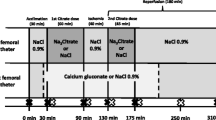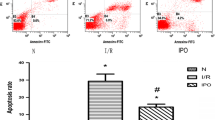Summary
This presentation briefly reviews the cellular mechanism of ischemic acute renal failure (ARF) with particular emphasis on the role of Ca2+ and calcium entry blockers (CEB). Vascular consequences of an ischemic renal insult including vasoconstriction, diminished glomerular permeability, loss of autoregulation, and hypersensitivity to renal nerve stimulation may relate to increased cellular Ca2+ concentration in the renal afferent arteriole and glomerular mesangial cells. Evidence is also presented that the ischemic injury to tubular plasma membranes is associated with increased Ca2+ uptake. With an ischemic insult of a short duration, the renal mitochondria are able to buffer the increased cellular Ca2+. However, after an ischemic insult of long duration, the Ca2+ overloaded mitochondria deteriorate, adenosine triphosphate (ATP) synthesis decreases, and cell death follows. If a sufficient number of renal tubular cells undergo this cell death, tubular obstruction, i.e. the maintenance phase of ARF, occurs.
Similar content being viewed by others
References
Cronin RE, Erickson AM, De Torrente A, McDonald KM, Schrier RW (1978) Norepinephrine-induced acute renal failure: A reversible ischemic model of acute renal failure. Kidney Int 14:187–190
Matthys E, Patton MK, Osgood RW, Venkatachalam MA, Stein JH (1983) Alterations in vascular function and morphology in acute ischemic renal failure. Kidney Int 23:717–724
Adams PL, Adams FF, Bell PD, Navar LG (1980) Impaired renal blood flow autoregulation in ischemic renal failure. Kidney Int 18:68–76
Kelleher SP, Robinette JB, Conger JD (1984) Sympathetic nervous system in the loss of autoregulation in acute renal failure. Am J Physiol 246:F379-F386
Cheung JY, Constantine JM, Bonventre JV (1986) Regulation of cytosolic free calcium concentration in cultured renal epithelial cells. Am J Physiol 251:F690-F701
Carafoli E (1979) The calcium cycle of mitochondria. FEBS Lett 104:1–5
Moore CL (1971) Specific inhibition of mitochondrial Ca++ transport by ruthenium red. Biochem Biophys Res Comm 42:298–305, 1971
Rossi CS, Lehninger AL (1964) Stoichiometry of respiratory stimulation, accumulation of Ca2+ and phosphate, and oxidative phosphorylation in rat liver mitochondria. J Biol Chem 239:3971–3980
Conger JD, Robinette JR, Schrier RW (1988) Smooth muscle calcium and endothelium derived relaxing factor in the abnormal vascular responses of acute renal failure. J Clin Invest (in press)
Burke TJ, Arnold PE, Gordon JA, Bulger RE, Dobyan DC, Schrier RW (1984) Protective effect of intrarenal calcium membrane blockers before or after renal ischemia. Functional, morphological and mitochondrial studies. J Clin Invest 74:1830–1841
Goldfarb D, Iaina A, Serbon I, Govendo S, Koupler S, Eliahou HE (1983) Beneficial effect of verapamil in ischemic acute renal failure in the rat. Proc Soc Exp Biol Med 172:389–392
Wait RB, White G, David JH (1983) Beneficial effects of verapamil on postischemic renal failure. Surgery 94:276–282
Malis CD, Cheung JY, Leaf AL, Bonventre JV (1983) Effects of verapamil in models of ischemic acute renal failure in the rat. Am J Physiol 245:F735-F742
Shapiro JI, Cheung C, Itabashi A, Chan L, Schrier RW (1985) The effect of verapamil on renal function after warm and cold ischemia in the isolated perfused rat kidney. Transplantation 40:596–600
Wagner K, Albrecht S, Neumayer HH (1986) Prevention of delayed graft function in cadaveric kidney transplantation by a calcium antagonist. Preliminary results of two prospective randomized trials. Transplantation Proc 18:510–515
Goldberg JD, Schrier RW (1984) Effect of calcium membrane blockers on in vivo vasoconstrictor properties of norepinephrine, angiotensin II and vasopressin. Mineral Electrolyte Metab 10:178–183
Meyer-Lehnert H, Takeda K, Schrier RW (1986) Effects of arginine vasopressin on calcium kinetics and cell contraction in cultured vascular smooth muscle cells (abstract). Clin Res 34:482A
Takeda K, Meyer-Lehnert H, Kim JK, Schrier RW (1988) Effect of angiotensin II on Ca2+ kinetics and contraction in cultured rat glomerular mesangial cells. Am J Physiol 254:F254-F266
Takeda K, Meyer-Lehnert H, Kim JK, Schrier RW (1988) AVP-induced Ca2+ fluxes and contraction of rat glomerular mesangial cells. Am J Physiol (in press)
Bonventre JV, Skorecki KL, Kreisberg JI, Cheung JY (1986) Vasopressin increases cytosolic free calcium concentration in glomerular mesangial cells. Am J Physiol 251:F94-F102
Ichikawa I, Miele JF, Brenner BM (1979) Reversal of renal cortical actions of angiotensin II by verapamil and manganese. Kidney Int 16:137–147
Cheung JY, Leaf A, Bonventre JV (1984) Mechanism of protection by verapamil and nifedipine from anoxic injury in isolated cardiac myocytes. Am J Physiol 246:C323-C329
Solez L, Morel-Maroger L, Sraer J (1979) The morphology of “acute tubular necrosis” in man: Analysis of 57 renal biopsies and comparison with the glycerol model. Medicine 58:362–376
Schrier RW, Arnold PE, Van Putten VJ, Burke TJ (1987) Pathophysiology of cell ischemia, Chapt 47. In: Schrier RW, Gottschalk CW (eds) Diseases of the Kidney, 4/e. Little Brown, Boston
Burnier M, Van Putten V, Wilson P, Burke T, Schrier RW (1985) Beneficial effects of verapamil and nifedipine on Ca influx and cell viability in anoxic renal cortical proximal tubules. Mineral Electrolyte Metab 11:390–391
Burke TJ, Cronin RE, Duchin KL, Peterson LN, Schrier RW (1980) Ischemic and tubular obstruction during acute renal failure in dogs: Mannitol in protection. Am J Physiol 238:F305-F314
Donohoe JF, Venkatachalam MA, Bernard DB, Levinsky NG (1978) Tubular leakage and obstruction after renal ischemia: Structure-function correlations. Kidney Int 13:208–222
Cronin RE, De Torrente A, Miller PD, Bulger RE, Burke TJ, Schrier RW (1978) Pathogenetic mechanisms in early norepinephrine-induced acute renal failure: Functional and histological correlates of protection. Kidney Int 14:115–125
Wong SME, Chase HS Jr (1986) Role of intracellular calcium in cellular volume regulation. Am J Physiol 250:C841-C852
Trump BF, Berezesky IK, Laiho KV, Osornio AR, Mergner WJ, Smith MW (1980) The role of calcium in cell injury. A review. Scanning Electron Microscopy 2:437–462
Arnold PE, Van Putten VJ, Lumlertgul D, Burke TJ, Schrier RW (1986) Adenine nucleotide metabolism and mitochondrial Ca2+ transport following renal ischemia. Am J Physiol 250:F357-F363
Chien KR, Abrams J, Pfau RG, Farber JL (1977) Prevention by chlorpromazine of ischemic liver cell death. Am J Physiol 88:539–558
Schanne FAX, Kane AB, Young EE, Farber JL (1979) Calcium dependence of toxic cell death: A final common pathway. Science 206:700–702
Chien KR, Abrams J, Serroni A, Martin JT, Farber JL (1978) Accelerated phospholipid degradation and associated membrane dysfunction in irreversible, ischemic liver cell injury. J Biol Chem 253:4809–4817
Matthys E, Patel Y, Kreisberg J, Stewart JH, Venkatachalam M (1984) Lipid alterations induced by renal ischemia: Pathogenic factor in membrane damage. Kidney Int 26:153–161
Takano T, Soltoff SP, Murdaugh S, Mandel LJ (1985) Intracellular respiratory dysfunction and cell injury in short-term anoxia of rabbit renal proximal tubules. J Clin Invest 76:2377–2384
McCord JM (1985) Oxygen-derived free radicals in post-ischemic tissue injury. N Engl J Med 312:159–163
Paller MS, Hoidal JR, Ferris TF (1984) Oxygen free radicals in ischemic acute renal failure in the rat. J Clin Invest 74:1156–1164
McCord JM, Roy RS (1982) The pathophysiology of superoxide: Roles in inflammation and ischemia. Can J Physiol Pharmacol 60:1346–1352
Burnier M, Burke T, Shanley P, Schrier R (1986) Effect of extracellular acidosis on enhanced Ca influx in anoxic renal proximal tubules (abstract). Kidney Int 29:299
Van Den Bosch H (1982) Phospholipases, Chapt 9. In: Hawthorne JN, Ansell GB, Elsevier Biomedical Press, Nottingham and Birmingham (New Comprehensive Biochemistry Series, Vol 4, p 313)
Busa WB, Nuticelli R (1984) Metabolic regulation via intracellular pH. Am J Physiol 246:R409-R438
Molitoris BA, Wilson PD, Schrier RW, Simon FR (1985) Ischemia induces partial loss of surface membrane polarity and accumulation of putative calcium ionophores. J Clin Invest 76:2097–2105
Hems DA, Brosnan JT (1970) Effects of ischaemia on content of metabolites in rat liver and kidney in vivo. Biochem J 120:105–111
Mason J, Beck F, Dorge A, Rick R, Thurau K (1981) Intracellular electrolyte composition following renal ischemia. Kidney Int 20:61–70
Snowdowne KW, Freudenrich CC, Borle AB (1985) The effects of anoxia on cytosolic free calcium, calcium fluxes, and cellular ATP levels in cultured kidney cells. J Biol Chem 260:11619–11626
Snowdowne KW, Borle AB (1984) Measurement of cytosolic free calcium in mammalian cells with aequorin. Am J Physiol 247:C396-C408
Wilson PD, Schrier RW (1986) Nephron segment and calcium as determinants of anoxic cell death in primary renal cell cultures. Kidney Int 29:1172–1179
Schwertschlag U, Schrier RW, Wilson P (1986) Beneficial effects of calcium channel blockers and calmodulin binding drugs on in vitro renal cell anoxia. J Pharmacol Exp Ther 238:119–124
Schieppati A, Wilson PD, Burke TJ, Schrier RW (1985) Effect of renal ischemia on cortical microsomal calcium accumulation. Am J Physiol 249:C476-C483
Wilson DR, Arnold PE, Burke TJ, Schrier RW (1984) Mitochondrial calcium accumulation and respiration in ischemic acute renal failure in the rat. Kidney Int 25:519–526
Arnold PE, Lumlertgul D, Burke TJ, Schrier RW (1985) In vitro versus in vivo mitochondrial calcium loading in ischemic acute renal failure. Am J Physiol 248:F845-F850
Becker GL, Fiskum G, Lehninger AL (1980) Regulation of free Ca2+ by liver mitochondria and endoplasmic reticulum. J Biol Chem 255:9009–9012
Patak RV, Fadem SZ, Lifschitz MD, Stein JH (1979) Study of factors which modify the development of norepinephrine-induced acute renal failure in the dog. Kidney Int 15:227–237
De Torrente A, Miller PD, Cronin RE, Paulsen PE, Erickson AL, Schrier RW (1978) Effects of furosemide and acetylcholine in norepinephrine-induced acute renal failure. Am J Physiol 235:F131-F136
Meyer-Lehnert H, Caramelo C, Tsai P, Schrier RW (1988) Interaction of atriopeptin III and vasopressin on calcium kinetics and contraction of aortic smooth muscle cells. J Clin Invest (in press)
Nakamoto M, Shapiro JI, Shanley PF, Chan L, Schrier RW (1988) In vitro and in vivo protective effect of atriopeptin III on ischemic acute renal failure. J Clin Invest 80:698–705
Malis CD, Bonventre JV (1986) Mechanism of calcium potentiation of oxygen free radical injury to renal mitochondria. A model for postischemic and toxic mitochondrial damage. J Biol Chem 261:14201–14208
Harris DCH, Hammond WS, Burke TJ, Schrier RW (1987) Verapamil protects against progression of experimental chronic renal failure. Kidney Int 31:41–46
Schrier RW, Arnold PE, Van Putten VJ, Burke TJ (1987) Cellular calcium in ischemic acute renal failure: Role of calcium entry blockers (editorial). Kidney Int 32:313–321
Author information
Authors and Affiliations
Rights and permissions
About this article
Cite this article
Schrier, R.W., Hensen, J. Cellular mechanism of ischemic acute renal failure: Role of Ca2+ and calcium entry blockers. Klin Wochenschr 66, 800–807 (1988). https://doi.org/10.1007/BF01728940
Issue Date:
DOI: https://doi.org/10.1007/BF01728940




